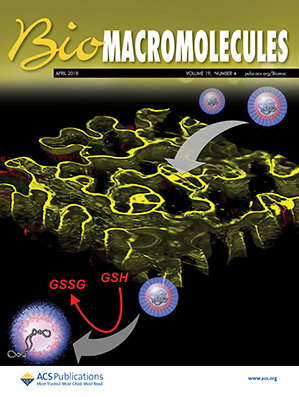Viscoelastic Behavior of Aqueous Hydroxypropyl Cellulose Solutions Due to Entanglements
IF 5.4
2区 化学
Q1 BIOCHEMISTRY & MOLECULAR BIOLOGY
引用次数: 0
Abstract
Hydroxypropyl cellulose (HpC) forms a liquid crystalline phase and is thought to have a rod-like shape in aqueous solution. The viscoelastic behaviors of aqueous solutions of HpC samples with average molar substitution numbers (MS ∼ 3.8) and weight-average molar masses (M w = 36–740 kg mol–1) were examined over a wide concentration (c) range, and the results were discussed based on a concept of rod particle suspension rheology. The c and M w dependencies of viscoelastic parameters determined in the frequency range showing flow behavior, such as the zero-shear viscosity, the average relaxation time, and the steady-state compliance in the c range for HpC molecules to fully entangle, were considered by using the number density (ν = cN A/M w, where N A is the Avogadro constant), the intrinsic viscosity, and the average rod particle length of HpC molecules determined via dilute solution properties. The obtained relationships were successfully understood with the rod particle suspension rheology.
- Download: Download high-res image (153KB)
- Download: Download full-size image
羟丙基纤维素水溶液因缠结而产生的粘弹性行为。
羟丙基纤维素(HpC)形成液晶相,被认为在水溶液中具有棒状。研究了具有平均摩尔取代数(MS ~ 3.8)和重量-平均摩尔质量(Mw = 36-740 kg mol-1)的HpC样品水溶液在较宽浓度(c)范围内的粘弹性行为,并基于棒颗粒悬浮流变学的概念对结果进行了讨论。通过使用数密度(ν = cNA/Mw,其中NA为阿伏伽德罗常数)、特性粘度和稀溶液性质确定的HpC分子的平均棒粒长度来考虑在显示流动行为的频率范围内确定的粘弹性参数(如零剪切粘度、平均松弛时间和c范围内HpC分子完全纠缠的稳态依从性)的c和Mw依赖关系。所得到的关系成功地理解了棒状颗粒的悬浮流变性。
本文章由计算机程序翻译,如有差异,请以英文原文为准。
求助全文
约1分钟内获得全文
求助全文
来源期刊

Biomacromolecules
化学-高分子科学
CiteScore
10.60
自引率
4.80%
发文量
417
审稿时长
1.6 months
期刊介绍:
Biomacromolecules is a leading forum for the dissemination of cutting-edge research at the interface of polymer science and biology. Submissions to Biomacromolecules should contain strong elements of innovation in terms of macromolecular design, synthesis and characterization, or in the application of polymer materials to biology and medicine.
Topics covered by Biomacromolecules include, but are not exclusively limited to: sustainable polymers, polymers based on natural and renewable resources, degradable polymers, polymer conjugates, polymeric drugs, polymers in biocatalysis, biomacromolecular assembly, biomimetic polymers, polymer-biomineral hybrids, biomimetic-polymer processing, polymer recycling, bioactive polymer surfaces, original polymer design for biomedical applications such as immunotherapy, drug delivery, gene delivery, antimicrobial applications, diagnostic imaging and biosensing, polymers in tissue engineering and regenerative medicine, polymeric scaffolds and hydrogels for cell culture and delivery.
 求助内容:
求助内容: 应助结果提醒方式:
应助结果提醒方式:


